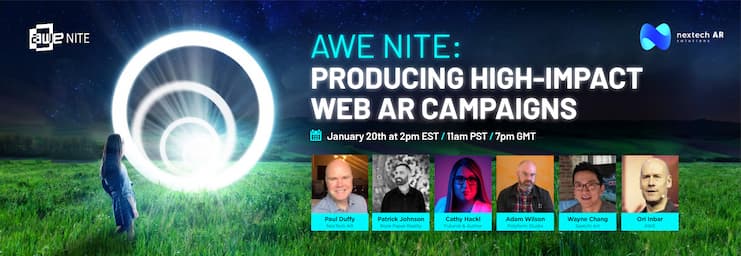
There’s a growing realization that apps aren’t always the optimal vessel for AR. Yet with mobile AR, it’s born on a device where apps rule. 90 percent of mobile users’ time is spent in apps versus the web. Can AR break that cycle? And if so, could web AR be the answer?
As background, Web AR resides within the mobile browser. Advantages include dynamism for AR’s serendipity and short sessions, versus the friction of app stores and downloads. The latter’s “activation energy” dampens AR adoption, which is already challenged to begin with.
For example, will consumers spend 90 seconds downloading an app for an experience that lasts 30 seconds? Consider this in light of dynamic AR activations within a store aisle or social interaction. These scenarios happen fast and need an AR delivery system that aligns with that.
To synthesize web AR dynamics, specifically in the context of AR advertising, AWE Nite recently held a virtual event with a panel of heavy hitters. We’re featuring it in two-parts of our weekly XR Talks series, including video and takeaways. Following part I last week, see part II below.

Goal Setting
Picking up where we left off in Part I, what are more granular tactics and success factors for web-AR-based marketing? Like in most successful advertising campaigns, the discovery phase is critical, says RPR’s Patrick Johnson. It’s all about clear goal-setting for brand objectives.
This involves mapping out the campaign’s endpoints, such as brand awareness (upper-funnel) or revenue lift (lower-funnel). It’s also about defining targeted personas that the campaign — and thus the brand — is meant to engage. These steps directly steer campaign strategy.
For example, when working with brand clients, Johnson sometimes advises them not to do AR. This happens whenever it’s discovered in early phases that their goals don’t align with AR and they’re instead driven by “tech for tech’s sake.” This can set up any campaign to fail.
It’s likewise important to gauge advertisers’ financial commitment. What’s their paid ad budget? This will impact what and how many channels an AR experience can be distributed to. As mentioned in Part I, omnichannel approaches can boost campaign performance.
AR Clickstream
Another important campaign tactic comes down to activation points. In other words, where and when is the AR experience activated? Calls-to-action should be strategically placed in the paths of targeted users, whether that’s websites, social posts or QR codes in print media.
Effectiveness here traces back to the all-important discovery stage referenced above. Know the campaign’s target personas and the media touchpoints to which they’re endemic. Beyond the initial call-to-action, it’s also advisable to map out the entire experience and clickstream.
In other words, optimize the flow from call-to-action, to AR activation to post-exposure action. The latter goes back to campaign goals and can include things like social shares, or buying a given product. Build the experience around that flow and steer users toward intended actions.
NexTech’s Paul Duffy also asserts that simplicity is key. Use clean design and large AR activation buttons that are above the fold on a given eCommerce page. Once users click, it has to be a seamless launch. As mentioned in Part I prioritize performance over graphical intensity.
Arts & Sciences
Of course, all of the above is easier said than done. How do you know where to place calls to action and optimize a given experience? The answer is to work with an agency like RPR that’s refined its playbook around web AR tactics, and/or develop your own competency through testing.
Sattchi Art has done both. Wayne Chang stresses the importance of analytics, as his team is currently evaluating where they should put AR calls-to-action. They’re now on individual product pages but should they also exist further up the funnel as more of a discovery tool?
Either way, engaging users at all points of the funnel will get easier as AR culturally assimilates. This will accelerate as the underlying tech continues to make AR more compelling and user-friendly. For example, Lidar could do for AR what smartphones have done for photography.
Meanwhile, it’s all about fundamentals. As noted, that includes campaign goal setting, planning and execution. Then it’s all about perpetual testing and course-correcting based on results. In other words, just like the broader ad world, web AR will be part art and part science.
See the full panel discussion below, and see part I of this series here.
Editor’s Note: The author of this article owns stock in NextTech AR Solutions. See AR Insider’s disclosure and ethics policy here.






